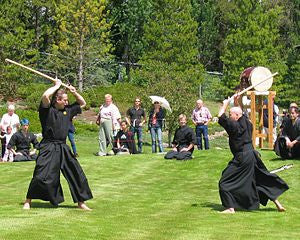Your Cart is Empty


Japanese kenjutsu is a popular form of martial arts that specifically emphasizes swordsmanship. While it originated out of feudal Japan, it's since found its way into the modern world. If you're thinking about learning kenjutsu, though, you should familiarize yourself with the five different guard postures.
#1) Chūdan-no-kamae
Chūdan-no-kamae is the middle posture used in kenjutsu. The most basic stance, it allows for a balance between attacking and defense. When performed correctly, the practitioner's trunk and right wrist are protected in the chūdan-no-kamae posture. Students learn this posture first so they know the correct striking distance.
To create the chūdan-no-kamae posture, you should place your left foot a few inches behind your right foot, while keeping your left heel elevated. Your hips should remain forward and shoulders relaxed.
#2) Jōdan-no-kamae
Jōdan-no-kamae is the high posture used in kenjutsu. Abbreviated jōdanfor short, it involves keeping your sword raised above your head, with the tip of the blade pointed back (see image above).
There are actually different styles of jōdan-no-kamae: one involves keeping your foot in front, while the other involves holding the sword with a single hand, the former of which is usually the most popular style in kenjutsu.
#3) Gedan-no-kamae
Gedan-no-kamae is the low posture used in kenjutsu. To perform this posture, the practitioner places his or her sword out in front of their body, pointing it at either the waist (for kendo) or the knee (for kenjutsu).
Gedan-no-kamae is classified as a style of chūdan-no-kamae, so it creates the perception of a defense posture but allows the practitioner to deflect blows and perform counterattacks.
#4) Hassō-no-kamae
Hassō-no-kamae is the "eight-sided" posture used in kenjutsu. With this posture, the practitioner places his or her left foot in front, while holding their sword upright in a near-vertical position with the hilt in front of their right shoulder.
Hassō-no-kamae is a purely offensive posture, receiving its namesake for the emphasis is places on situational awareness.
#5) Waki-gamae
Waki-gamae is the side posture used in kenjutsu. It involves hiding the sword behind the practitioner's body, exposing only the sword's pommel to the practitioner's opponent.
Waki-gamae was a popular stance before there were restrictions regarding blade length. As such, practitioners would use this stance to hide the length of their sword, essentially luring their opponent into striking distance. Furthermore, it allows practitioners to make surprise attacks by concealing the movement of their sword.